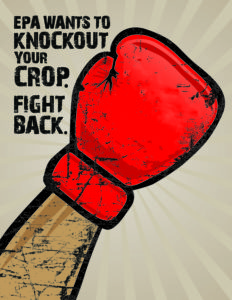
Swipe For More >
With ample attention on the Environmental Protection Agency and Administrators in 2018 primarily related to the Renewable Fuels Standard, it is important we turn our focus and examine the agency on another critical area of importance to farmers and ranchers, the crop protection side, as progress is not going well and demands grower attention.
Every growing season, American farmers rely on crop protection products to mitigate crop damage from weeds, insects and diseases. Many of these products have been safely utilized for decades but in recent years have become the target for increased regulatory pressure.
Chemical registrants, and endlessly growers, face a three-way regulatory challenge not only from the EPA, but also the U.S. Fish and Wildlife Service and National Marine Fisheries that threaten the re-registration process for hundreds of crop protection tools critical to farmer success. One of the oldest, most studied and most important tools for weed control in sorghum is atrazine, which is used on approximately 60 percent of U.S. sorghum acres annually.
Sorghum producers submitted thousands of comments in the summer of 2016 defending the product after the release of the EPA’s Ecological Risk Assessment for atrazine. To date, the EPA ignored several quality, important studies while also ignoring the conclusions of its own 2012 Scientific Advisory Panel. Now, the Cumulative Human and Health Risk Assessment for atrazine has been released as part of the re-registration review process, and NSP needs sorghum producer support once again.
Atrazine is one of many crop protection products producers will need to fight for between now and 2022 as active ingredients are being reviewed or re-registered. The Federal Insecticide, Fungicide and Rodenticide Act (FIFRA) provides the framework for evaluating risks and benefits and evidence-based decisions regarding the registration of active ingredients and associated formulations. Each active ingredient goes through a robust and lengthy approval process and once registered, undergoes regular reviews to allow the product registration to continue.

There have been few new herbicide active ingredients commercialized in the last 30 years, and the horizon does not look promising for new products. It is critical that scientifically proven, safe active ingredients remain available for use by producers. Since the original passage of U.S. pesticide laws in 1910, and following major revisions to the FIFRA in 1972 and 1996, there has generally been a clear path to the registration and re-registration of crop protection products.
The studies required by the EPA regarding ecological risk and human health risk assessments were science based, and the benchmarks that must be met by a product were well known. Chemical registrants had a level of certainty when evaluating active ingredients before submitting the product for registration. Unfortunately, there is now much uncertainty as to the regulatory path of a new active ingredient. This greatly discourages the investment needed by companies to discover and bring to the market new safe active ingredients.
How did we get here? During the second term of the Obama Administration that certainty began to erode. For decades, animal toxicology studies were seen as the gold standard for human health risk assessment, but the agency shifted attention and weight of evidence toward more nebulous epidemiological studies. For ecological risk assessments, EPA augmented water and soil degradation models to make them more conservative and deemphasized field and monitoring data. These changes, and others, created a registration process that was far more precautionary and reflective of European models toward innovation.
Despite expectations of swift action by the Trump Administration to address the uncertainty concerns and smooth the regulatory process, particularly around risk assessments, little has been done thus far. This is in large part due to the EPA having few political positions filled and a lack of expertise and emphasis in pesticide policy among those who are in place. Without the necessary changes to the overly conservative assessments that were baked into the process in the last Administration, agriculture is very much at risk of losing important active ingredients such as atrazine, chlorpyrifos and the neonicotinoid class of insecticides.
NSP is regularly engaging with career and political staff at the EPA, making the case for a re-evaluation of the agency’s overly conservative approach to environmental risk assessments related to pollinators and endangered species while encouraging the EPA to embrace a probabilistic and real-world science-based methodology, just as the Agency does with human health risk assessments.
NSP also regularly coordinates with CropLife America and the Pesticide Policy Coalition on messaging to Capitol Hill and the EPA on these issues. We are at a critical time in history and if there was ever a time to be engaged in the fight, the time is now, as precedence will likely determine the future of crop protection products. The risks of not engaging and working with the regulatory community to address these procedural pitfalls could have generational impacts on the ability for farmers to utilize crop protection products for decades to come.

